
Qinghai station of the Purple Mountain Observatory on the Gobi desert.
A white dome, like a huge golf ball, sits in the Gobi Desert about 3,200 meters above sea level. Enclosed inside, a large telescope scans the vast Milky Way day and night.
The 21-meter-high dome was erected 35 kilometers east of Delingha City, northwest China's Qinghai Province, about three decades ago.
At first, it drew the attention of Mongolian herdsmen living nearby, as it looked like a huge yurt from a distance. On horses and camels, they came to look.
"Most mistook it as a meteorological station, and they often called to ask about the weather. We had to tell them again and again that we were observing the stars," laughs Pang Xinghai, a senior engineer who has worked at the Qinghai station of the Purple Mountain Observatory (PMO) for 36 years.
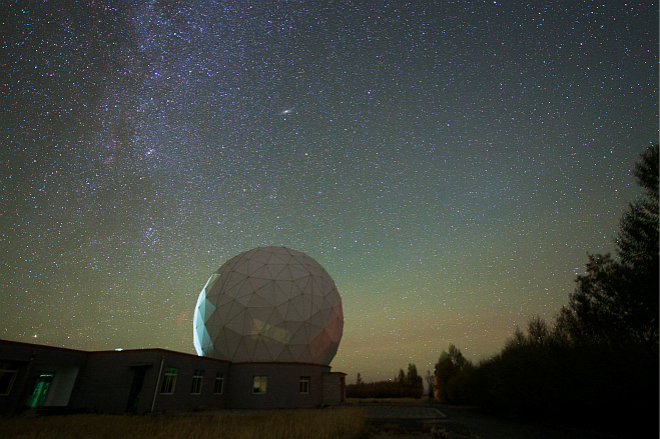
13.7-meter millimeter-wave radio telescope under the starry sky. Photo provided by PMO
With a diameter of 13.7 meters, it is China's only large radio telescope working at the millimeter wave band, providing data for a series of key astronomical studies, and it's open to astronomers worldwide.
It is mainly used to study molecular clouds and the formation of stars, as well as planetary nebula, the evolution of stars, and interstellar matter, says Xu Ye, chief scientist at the station.
The dry weather and high altitude on the Qinghai-Tibet Plateau, known as the roof of the world, makes it the best site in Asia for millimeter-wave radio astronomical observation, Xu says.
The station is also home to other optical facilities, and is one of the ground stations for experiments conducted with the world's first quantum satellite, Quantum Experiments at Space Scale (QUESS).
TELESCOPE GUARDIANS
The telescope was constructed in the 1980s and put into use in 1990. Since then, scientists and engineers have stayed in the Gobi Desert's harsh environment for decades to peer into the boundless universe.
Ju Binggang, vice director of the station, who has worked there for 18 years, recalls how the road from Delingha City to the station was once so bad that their car bounced along for two to three hours every day.
The drinking water pumped from underground gave him diarrhea just after he arrived. The high altitude and dry weather gave the staff nose-bleeds, chapped lips and sleepless nights.
"Our duty is to ensure the smooth operation of the telescope. If there is any malfunction, we rush to repair it - even if it's midnight," Ju says.
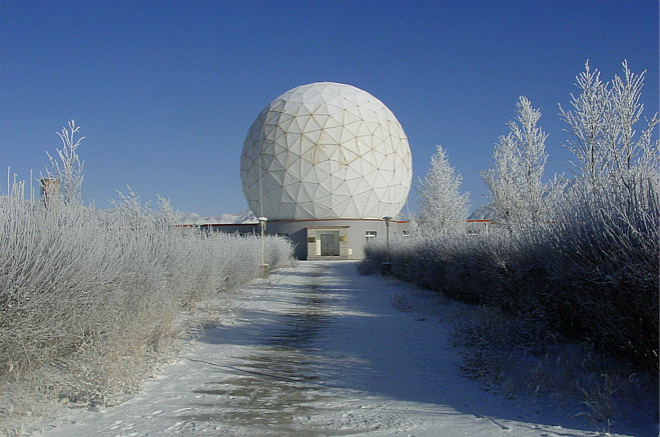
Winter scenery at the Qinghai station of the Purple Mountain Observatory.
Winter is the most important observation season, so the station never shuts during the Chinese Lunar New Year, the most important Chinese festival of family reunion.
"The core instrument of the telescope works at a temperature of around 269 degrees centigrade below zero. If we shut it down and restart it, the process will waste a lot of time and might cause accidents. So the telescope runs continuously for 10 months a year except for the rainy season in July and August," Xu Ye says.
Even during the rainy season, staff never rest.
"The telescope might become 'shortsighted', as the dish antenna is made of aluminum panels that could distort by expanding in the heat and contracting in the cold. So we overhaul the telescope during the rainy season," Ju says.
"Just after I arrived here, I thought the environment was bleak and life dull. As time went on, I fell in love with the life and work. When the night is clear, I love to enjoy the starry sky," Ju says.
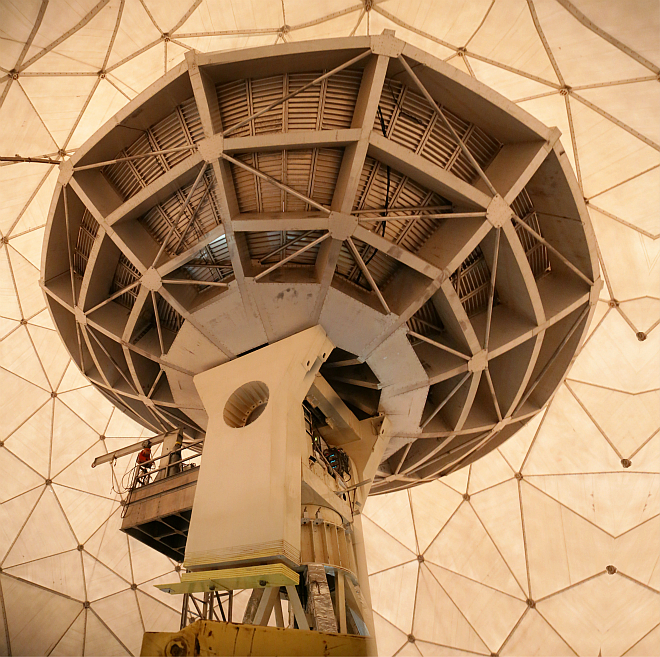
13.7-meter millimeter-wave radio telescope. Photo provided by PMO
Pang Xinghai, 55, originally planned to become a doctor or a soldier. But he failed the college entrance examination and enrolled in the Qinghai station of PMO in 1982.
"When the workers were building the telescope, they had to inhale oxygen to cope with the altitude," Pang recalls.
After working 36 years in the station, Pang will retire this year, but he's reluctant to leave. "Astronomers made many important discoveries through this telescope, and I also made a contribution," he says.
Li Zhenqiang graduated from university and came to work in the station in 2006. He lost almost half his hair in one year as he was not accustomed to the water and stayed up late.
He took postgraduate courses in PMO in east China's Jiangsu Province for two years - then chose to come back to the Qinghai station.
"I get a sense of achievement making discoveries from the telescope data," he says.
PORTRAIT OF GALAXY
In such a tough environment, Chinese astronomers carry out a grand and poetic project: painting a portrait of the vast Milky Way.
The Milky Way Imaging Scroll Painting project, led by Yang Ji, director of PMO, and launched in November 2011, is the largest project conducted with the 13.7-meter millimeter-wave telescope.
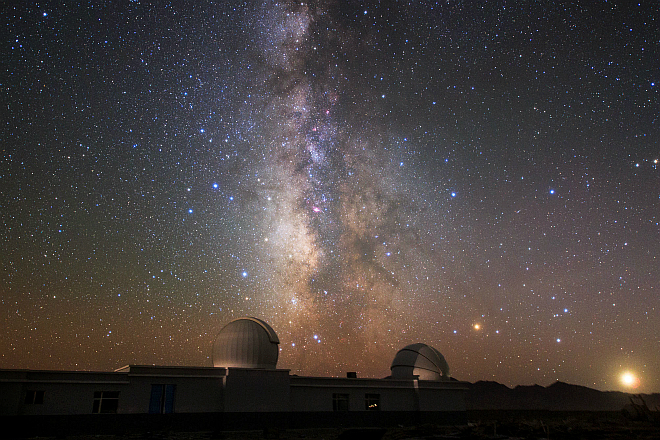
Qinghai station of the Purple Mountain Observatory under the Milky Way.
The Milky Way is an interesting subject for astronomers, due to the large number of stars and abundant gases in it. For a long time, scientists conducted observations, but mostly gathered fragmented data.
What's the detailed structure of the Milky Way? How do the stars form? How are the stars distributed? What is between stars? These are the mysteries of our galaxy.
The Milky Way Imaging Scroll Painting project aims to probe the distribution, structure and physical properties of molecular clouds to get a relatively complete picture of the structure of the Milky Way, Xu Ye says.
"The project will change our understanding of our galaxy," he says.
When the researchers finish observing one area of sky, they fill a small square on a chart hanging on the wall of their office. So far, they have filled more than 6,000 squares, meaning they have completed more than 60 percent of the project.
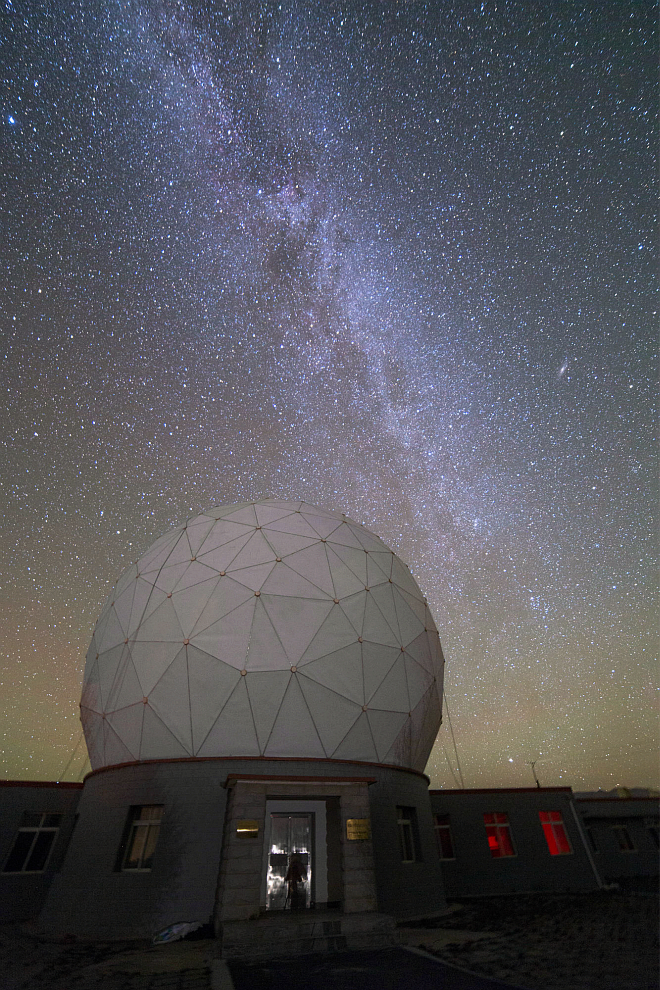
13.7-meter millimeter-wave radio telescope under the Milky Way. Photo provided by PMO
The observation and portrait of the whole galaxy is expected to be completed in another five years, says Xu.
"We can observe three molecular spectral lines that give us a clearer and more thorough picture of the celestial bodies. It's like we can see not only the eggshell but also the yolk and the white of the egg. The molecular spectral lines also contain information about the velocities of celestial bodies, so we can know whether they are moving toward us or away from us," Xu says.
A multi-beam receiver has been installed on the telescope to improve its observation ability by more than 50 times, Xu says.
The PMO plans to install a more advanced multi-beam receiver to observe the whole sky. It is also pushing forward the construction of a world-class submillimeter-wave radio telescope with a diameter of 60 meters, which can gaze to the edge of the universe more than 13 billion light years away, Xu says.

